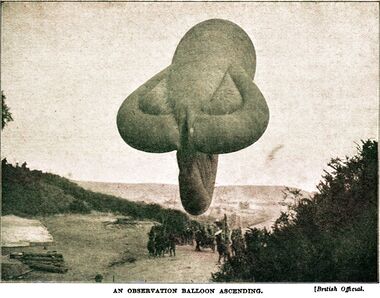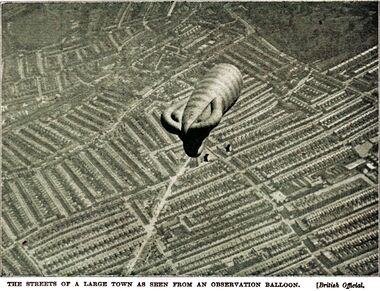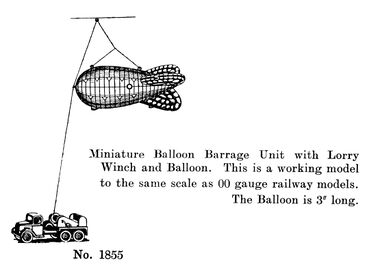Category:Observation and Barrage Balloons
1920: Observation Balloon, ascending [image info]
1920: Three-Lobed Kite Balloon [image info]
1920: Observation Balloon, above a town [image info]
1940: Minic Barrage Balloon Set [image info]
1940: the smaller Britains set, scaled for 00-gauge [image info]
Observation Balloons and Barrage Balloons were usually based on a design known as a Kite Balloon.
Completely or partly filled with hydrogen, this was a three-lobed inflatable balloon with three blobby inflated fins at the back, for stability. Designed to be tethered and to point into the wind, the tail fins looked childishly crude, but seem to have been effective.
Britain seems to have been a little slow to understand the advantages of the "Kite Balloon" design, and some of the early British barrage balloons were still using a simple spherical design, which made them more limited in the range of wind speeds in which they could be deployed.
Observation Balloons
An observation balloon could lift a camera with a remote shutter cable for photography, or (more often) a human observer. An observer hoisted aloft on an observation balloon on one side of a set of battle-lines would be able to see layouts of the opposition's trenches and other defences, which was obviously useful. However, this also meant that when one side saw the other sending an observer aloft, they had a strong incentive to send a plane to shoot it down (or shoot the observer before they could report back). The officers sent aloft apparently were unarmed or armed only with their service handgun. According to hearsay from World War One, officers sent up as observers had to be very nice to their ground crews ... if they treated them badly, and were hated, all the ground crew had to do was to be a little bit too slow in winching the balloon back down again when an enemy aircraft appeared, and their "officer problem" was solved...
1919: Use of "Spotter" balloons
Captive Balloons and their Use in War
"IN spite of clouds and thick haze, observation was carried out for our artillery both by aeroplanes and balloons." The balloons referred to in this extract from a typical official communiqué are similar craft to those queer sausage-like objects that were to be seen almost daily during the War floating over certain suburbs of London and other places. Known as kite, captive, or Drachen balloons they Were employed very extensively to direct the fire of heavy artillery.
By no stretch of imagination can they be classed as beautiful, but their extreme usefulness compensates for their ungainly appearance. Picture a little wooded declivity half a mile or so off one of those tediously direct, tree-lined Flanders roadways. The sun is breaking through the mist on the distant hills. All around the grim agents of the battle area are bestirring themselves for the day's work. The great balloon, streaked with all manner of colours to screen it, if possible, from the eyes of prying enemy pilots, is released from the numerous sandbags that have given it anchorage for the night. A large basket-car is dragged out from the shelter of the neighbouring woods and attached to the base. The rigging is adjusted. Into the basket clamber two observers in brown leather flying-coats. With creaks and groans the ground winch pays out the necessary cable, and the balloon steadily sails up into the heavens.
The question arises, if the same work could be done by aeroplanes, why employ these cumbrous craft, which have the disadvantage of being stationary? The explanation is that, however useful in other respects, aeroplanes can never attain the steadiness of a captive balloon. And steadiness, when one had to reckon in terms of yards on a ten mile front, is essential. A mistake might have resulted in firing into the backs of our own infantry, or in shelling an unoccupied position and thus wasting much useful and expensive ammunition.
Aloft, the two observers sit with their glasses to their eyes; now and then poring over their maps, and scouring the countryside for the objectives upon which the guns for which they are "spotting" will shortly be ranged. Down by the winch the telephone operator will be getting into contact by wire across the countryside with the gunners, who, in their turn, are put through to the "spotters" in the balloon.
Presently there is a buzz in the balloon. The battery is speaking: "About to open fire; keep your eyes open."
The observers concentrate on the objective, and immediately will come the reply to the guns — " Twenty yards right of the target."
A second or so's lapse, and again there will be a burst of white and grey smoke over the distant trench, ammunition dump, or enemy headquarters, as the case may be. Again the battery will inquire, "How did my last shot go?" And perhaps this time will come the reply, "Thirty yards under," or "Fifteen yards over." Finally, with a fevered hiss, will come to the battery the welcome news, "O.K.; keep on rapid fire."
All the time the guns are firing the kite balloon will be floating high behind them, registering their shots. And a spell of two or three hours' observation in a swaying balloon is not altogether a pleasant experience.
Long before the aeroplane came into being the establishment of every army included a number of observation balloons. The great trouble, however, with regard to their use was that they could not be kept stationary in the air. It was possible to anchor them only to one point, and when a gust struck the balloon the result was that the vessel was blown downward and down wind, in addition to which it would twirl in the air, to the great discomfort of the crew. Apart from discomfort, any observers who might be in the balloon would have all their calculations and estimates upset by a wind which would prevent them from taking measurements. For, with the balloon at a height of only half a mile, the swing produced by a wind, would be sufficient to take the balloon some distance from its mooring station. The rotatory movement caused by wind was stopped by an experimenter who, during the Russo-Japanese War, contrived a fin, or sail, which was fixed to the balloon and acted as a sort of rudder, keeping one side of the balloon always directly towards the wind. But this did not stop the balloon from being blown away from over its mooring station, and, of course, the higher it was in the air the farther it was blown.
The difficulty was finally overcome by the German Parseval-Siegsfield Company, who devised a gasbag of which the principle was employed in the building of captive balloons by all the belligerent nations. In this form of balloon the gasbag is sausage-shaped, and, as will be seen by the photographs, is so arranged that the nose or norward end is tilted up into the wind In consequence, the underside of the gasbag acts as a plane, and when the wind blows on it the result is a lifting tendency, which counteracts the inclination of the balloon to blow downward and away from its mooring station. At the lower and rear end of the balloon is a smaller bag with an opening that is kept facing toward the wind; as the wind blows into this it is inflated and thus acts as a rudder, holding the balloon steady in the air. It is not perfectly steady in a wind, of course, but nearly so, and the wind has not a quarter as much effect upon it as upon an ordinary spherical balloon.
Attached by stout steel rigging, the basket-car provides space for two men, together with their instruments, maps, etc. A steel cable connects the balloon to the ground winch, and prevents it from drifting. Behind the body floats a tail of six small parachutes. These are provided to anchor the craft against any sudden gust of wind, which might pitch the observers out of the basket.
If a very rapid ascent is required, instead of unwinding the anchoring cable off the drum as the balloon ascends, it is usual to unwind the cable from the drum altogether and to place it uncoiled on the ground, when the kite-balloon will ascend at a very quick rate.
Recently another shape of craft has made its appearance, the Cacquo balloon, invented by a captain of the French Army. Its main characteristics are a triple-bag appendage and increased stability, permitting the craft to be flown even in a full gale.
At sea observation balloons are if anything even more useful. The craft, when not in use, is stored in a specially constructed hold, and is sent up from the deck by winch and steel cable just as on land. In the Dardanelles campaign a kite balloon distinguished itself by directing the fire of the Queen Elizabeth across one side of the peninsula to the the other. For directing the fire of big guns at sea captive balloons proved invaluable.
The one disadvantage of the craft is that it is almost defenceless against enemy aeroplanes. When these tiny grey shapes came diving down from the skies, unless there was time to draw the balloon to the ground, the only course open to the observers was to take to the parachutes, which involved a great strain on the nerves. Imagine the sensation; plunging through space at perhaps a hundred miles an hour with but a few square feet of silken fabric to prevent one from dashing headlong to the ground. For the first sixty or eighty feet, before the parachute opens, one drops like a stone. The heavier the man the sooner the parachute unfolds. When it has unfolded, the apparatus falls gently down, following the course of the backward slope of the letter l, at the rate, approximately, of 4 feet 9 inches per second. Really the speed of the drop depends upon the weather conditions prevailing. Thus one parachutist took 35 minutes to drop 10,000 feet, while another took over 45 minutes to make a descent of only 6000 feet.
It does not necessarily follow that all observers were expected to drop in parachutes; they were only made use of as a last resource.
The K.B. observer is trained on both ordinary spherical balloons and captive balloons. He is as much a pilot as his brother of the aeroplane, from whom he is distinguished by wearing a half-wing on his tunic. In order to qualify he has to make five trips in a free balloon across country in order to practise landing the craft, should it ever break loose from its moorings. He must also make one night trip, and a trip alone.
For a youngster thinking of taking up flying for the adventure and excitement of the work, kite-ballooning cannot seriously be advised. It is a dull job compared with the excitement of aeroplane piloting. A large part of the personnel was latterly composed of gunners disabled in the War. The captive balloon proved to be one of the most valuable instruments of war, and at the close of hostilities was to be found on every mile of every front.
— , Edgar Middleton, , The Wonder Book of Aircraft, second edition, , 1919
Barrage Balloons
Barrage balloons were used both World Wars as low-level air defences against aircraft attacking a city, the principle being similar to the use of antisubmarine cables in waterways. A tethered balloon could dangle a number of cables, andiff an aircraft flew beneath and snagged a cable with its wing, it might be thrown into a spin, or with a large bomber, the weighted cable running over the wing surface at high speed could saw through the structure. The weight on cables could be due to the length of the cables themselves, or sometimes, for good measure, the equivalent of a landmine could be fitted to the cable, so that when a moving aircraft wing caught the cable, the explosives would ram upwards into the underside of the plane.
Although a pilot could avoid these cables simply by not flying beneath the balloons, ground crews could also string wires between balloons, and hang more cables from the linking cable. Being too good a pilot and flying between a pair of balloons at the maximum distance from both was liable to make you hit a central strung cable. Understandably, pilots assigned to bomb a target would be very unhappy to see barrage balloons deployed, especially for night raids.
- In World War One, barrage balloons were deployed at pretty much the maximum height for most aircraft.
- In World War Two, planes could fly above the maximum practical balloon height, which was limited by the weight (and therefore by the length of cable) that could be lifted. However, the higher-flying planes could be shot down more easily by anti-aircraft guns, which had more trouble getting a "fix" on the lower-altitude aircraft, due to the rate of change of angle of a plane flying past at high speed. This meant that barrage balloons still had a useful role to play, as well as being psychological deterrents.
Commercial models
In the UK, models of barrage balloons were made by Tri-Ang (Minic), Skybirds, and Britains Ltd. Because these toys were quite specialised, and only really made in the late 1930s in the buildup to WW2, and then discontinued in 1940, very few have survived, making them incredibly difficult to find in any kind of condition, let alone mint and boxed.
External links
Pages in category ‘Observation and Barrage Balloons’
The following 2 pages are in this category, out of 2 total.
Media in category ‘Observation and Barrage Balloons’
The following 9 files are in this category, out of 9 total.
- A three-lobed Kite Balloon (WBoA 4ed 1920).jpg 2,038 × 3,000; 1.21 MB
- Barrage Balloon Section, box lid (Britains 1749).jpg 967 × 2,400; 550 KB
- Barrage Balloon Unit, Britains 1855 (BritCat 1940).jpg 2,220 × 1,585; 201 KB
- Instructions for Assembling the Barrage Balloon, p1 (Britains 1749).jpg 2,040 × 2,400; 736 KB
- Instructions for Assembling the Barrage Balloon, p2 (Britains 1749).jpg 2,043 × 2,400; 766 KB
- Observation balloon above a town (WBoA 4ed 1920).jpg 3,000 × 2,298; 1.96 MB
- Observation Balloon Ascending (WBoA 4ed 1920).jpg 3,000 × 2,354; 1.67 MB
- Scale Model Balloon Barrage with Clockwork Winch Lorry, Minic (MM 1940-07).jpg 2,816 × 3,000; 609 KB
- Underslung Lorry with Driver (Britains 1641).jpg 2,400 × 835; 618 KB














